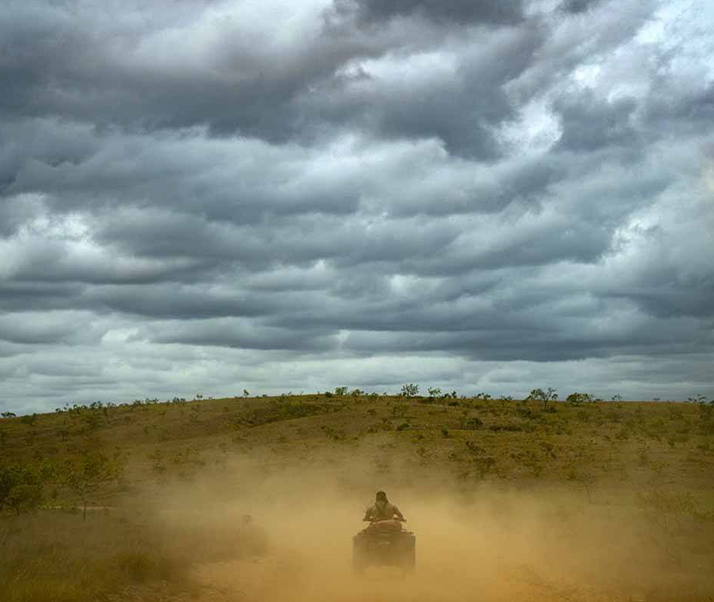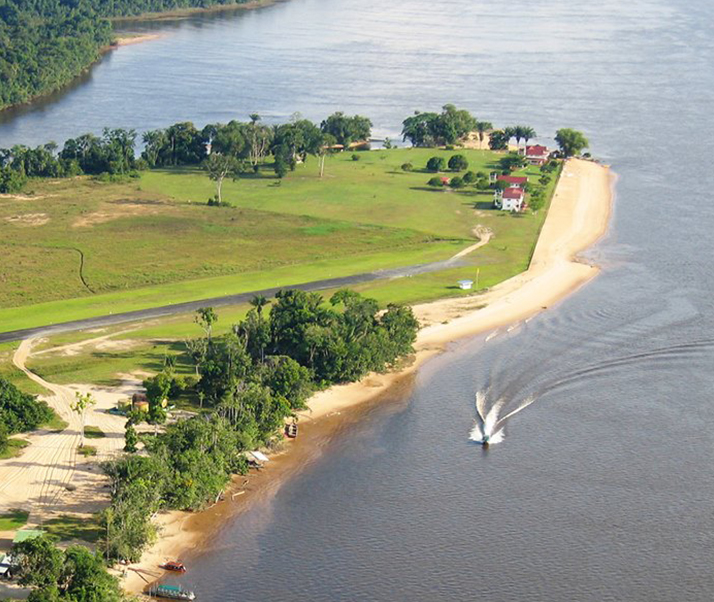+91 9884683139
talk to our Destination
specialist

Guyana isn't Latin: it sits alone on the continent of South America as an ex-British colony, sharing a Caribbean flavour where English is the first language and cricket the national sport.
Culturally it's a remarkable and unique melting pot of Afro-Caribbean, Amerindian, European, Brazilian and Asian influences: in the capital, Georgetown, a Hindu temple may sit happily next to a jerk-chicken fast food outlet while reggae music thunders from the bar across the road.
The country is composed of vast areas covered by virgin rainforest, savannah and ancient tablelands over one of which spill the stunning Kaieteur Falls. Deep in the almost untrodden interior there is magnificent jungle scenery and a plethora of wildlife unrivalled on the continent. Jaguars, giant otters, tapirs and over 800 bird species roam undisturbed.
Guyana is unique among South American countries in that it’s an anglophone country, thanks to its years as a British colony. Guyana gained independence in 1966. Guyanese tend to consider themselves a Caribbean country rather than a Latin American country and they’re part of CARICOM, the Caribbean country organization. The interior is defined by its Amerindian culture. English is the primary language, but Guyanese Creole is spoken on the coast and a variety of Amerindian languages are spoken in the interior.
Key Facts
7,86,552
Georgetown
Guyanese Dollar(GYD)
English
GMT -4
Oct - Apr

Guyana has six distinct ethnic groups, the majority being East Indian descent and Africans descent. The East Indians came to Guyana as indentured laborers; the Africans came to Guyana as slaves.
After multiple slave rebellions, slavery was abolished in 1838.East Indian culture dominates. Even when out in the most isolated parts of Guyana, Amerindian families listen to Hindi music as their children throw colored powders at each other to celebrate Holi (called Phagwa in Guyana).
With a vast mix of ethnic backgrounds, traditions, spiritual beliefs, festivals, architecture and landscapes, the memories of Guyana blaze long after travellers have left its shores. The rich cultural landscape of the country can best be explained as a mix of Caribbean culture (found mostly on the coast) and Indigenous roots (found more south in the country), with a dash of its colonial legacy which brought many other nationalities to live in Guyana. It can be experienced by attending festivals, staying with local communities in ecolodges, exploring the architectural heritage of the country, and indulging in Guyanese cuisine.
Abundantly fertile and blessed with year-round tropical weather, Guyana is rich in local foods and known for its exotic fruits, fresh vegetables and grains, free-range chicken and beef, and diversity of fish species.
Traditional Guyanese cuisine is inspired by the Indigenous Peoples, who have always lived off of the abundance of the land. Other influences stem from East Indians and Africans.
If there is one thing that stands out about Guyanese, it is that we love coming together and enjoying celebrations. Many festivals and events showcase the country’s colourful ethnic diversity. These events come alive through road parades and processions, street jams and parties.
Few places on the planet offer raw adventure as authentic as densely forested Guyana. Georgetown, the country's crumbling colonial capital, is distinctly Caribbean, with an alluring vibe, happening nightlife and some great places to eat. The interior of the country is more Amazonian, with its Amerindian communities and unparalleled wildlife-viewing opportunities tucked quietly away from the capital's noise and bustle. From sea-turtle nesting grounds along the country's north coast to monkeys and jaguars in the rainforest, and giant anteaters down in the southern savannas, Guyana's natural wonders are well worth the mud, bumpy roads and sweat.

The Capital City
Standing proudly where the mighty Demerara River pours into the Atlantic, Georgetown is by far Guyana's biggest city and a place all visitors will spend at least some of their time. Georgetown is the capital and springboard to the wonders of Guyana.
It makes for an ideal first stop for orientation, before you head further into the country. Framed by the endless Atlantic Ocean to the north, the city offers more than just a tropical welcome. The museums, heritage hotels, monuments and most of all, welcoming people, ensure that you are ready to jump into the stunning hinterland.
With its dilapidated architecture, unkempt parks and vibrant street life, Georgetown has a laid-back feel and considerable charm in parts.
Home today to the Caricom economic community, and thus a kind of Brussels of the Caribbean, Georgetown is no backwater, and its restaurants and nightlife reflect that, lending a distinctly cosmopolitan edge to the general chaos of a modern Guyanese city.

Jewel of Guyana’s Deep South
Far from Georgetown and the Atlantic coast, Guyana’s raffish border town is a gateway to neighbouring Brazil — and to the adventures of the Rupununi, with its rolling savannahs, misty mountains, forests, birds, and beasts.
Sprawling across a small triangle between the Takutu River, the airstrip, and the Rupununi Road, Lethem has no obvious centre and few major landmarks. Red laterite earth and the vast Rupununi sky may be the distinctive feature of this small town of simple dwellings and cashew trees, increasingly interspersed with guesthouses and modest hotels, eateries, and general goods stores stocked with Brazilian products. Portuguese is almost as common as English, and watering-holes are as likely to serve Brazilian Nova Schin beer as Guyanese Banks. On Lethem’s north-eastern outskirts are the rodeo grounds, home of the famous Easter Rodeo that draws numerous vacqueiros — cowboys — from near and far, to show off their skills with bucking broncos and lariats.
In Lethem, you have only to walk for a few minutes in any direction to find yourself in the open savannah, an astonishing country of red laterite earth broken by palm-lined creeks, sandpaper trees, anthills, and the blue Kanuku Mountains looming.
Further afield are the cattle ranches at Karanambu and Dadanawa, both of which host eco-tourists, and the positively sybaritic Rock View Lodge at Annai. They all offer ample opportunity to encounter wildlife, explore the Rupununi’s rivers and forests, and generally immerse yourself in a landscape of vast horizons.

Guyana’s Port City
Bartica, town, north-central Guyana, in tropical rainforests in which the Essequibo, Mazaruni, and Cuyuni rivers meet. Bartica, meaning ‘red earth’, lies at the confluence of the Essequibo, Cuyuni and Mazaruni Rivers and is popularly known as the gateway..
to the gold and diamond mining regions of Guyana. No wonder its main market street has entertainment hotspots in several pubs and shops for this bustling community. Bartica’s standout event is its annual Easter Regatta called the Bartica Regatta, where powerboat racing, street jams, music and even a pageant amp up the weekend, making it one of the best cultural travel destinations in Guyana.
Bartica is situated at the head of the Essequibo River, 50 miles (80 km) inland from the Atlantic Ocean, and it is linked by air with Georgetown, the national capital. Bartica is best connected to Georgetown by a one-hour road trip to Parika followed by boat. You can choose to take 4X4 vehicles the entire route for an adventurous ride.